The Cost of Late Meetings: How to Measure and Reduce the Impact
The cost of late meetings can be devastating to a company with lost time and money. Most businesses aren't even aware of how much late meetings cost...
Highlighting hidden costs of corporate meetings, the tools like the Flowtrace 'Meeting Cost Calculator' drive efficient, and cost-effective team work.
In the business world, meetings are a staple. From the boardrooms of multinational giants to the cozy conference rooms of startups, meetings are often seen as the heartbeat of business operations. They're where decisions are made, strategies are formed, and collaborations are fostered. But there's a significant aspect of these gatherings that often goes overlooked: their cost.
Now, you might think, "Of course, meetings have costs. There's the coffee, the snacks, perhaps the rental of an off-site meeting room now and then." But the true cost of meetings goes beyond these visible expenses. It seeps into the very fabric of how companies operate and how employees spend their time. For some businesses, the accumulated cost of meetings, especially ineffective ones, can run into the thousands or even millions annually.
Yet, in a paradoxical twist, it's sometimes easier to get approval for a $20,000 recurring meeting than to get that client lunch expense approved. Why? The answer lies not just in corporate policies and budgets but in a deeper, often unacknowledged, perception of what meetings represent in the corporate culture.
In this article, we'll unravel the complexities surrounding the real cost of meetings, shine a light on the surprising ways in which companies sometimes prioritize them over other expenses, and introduce a tool that could change how you and your teams view meetings forever: the "Meeting Cost Calculator" for Google Calendar.
And we are not talking about some isolated and simplistic app like promoted by Harvard Business Review.
Get ready to view your calendar invites in a whole new light.
When an employee glances at their calendar and sees a day filled with back-to-back meetings, the immediate emotion might be a mix of dread and resignation. Yet, beyond this emotional cost, there's a hefty financial one lurking in the background, often invisible to both employees and employers.
Salaries and Man-Hours: The most obvious cost is the collective salaries of everyone present. If you have a meeting with 10 managers, and they each have an hourly rate of, say, $80, then a one-hour meeting costs the company $800 in just salaries.
Resources and Amenities: There's also the cost of any resources used during the meeting, be it tech tools, projectors, whiteboards, or even the simple pen and paper.
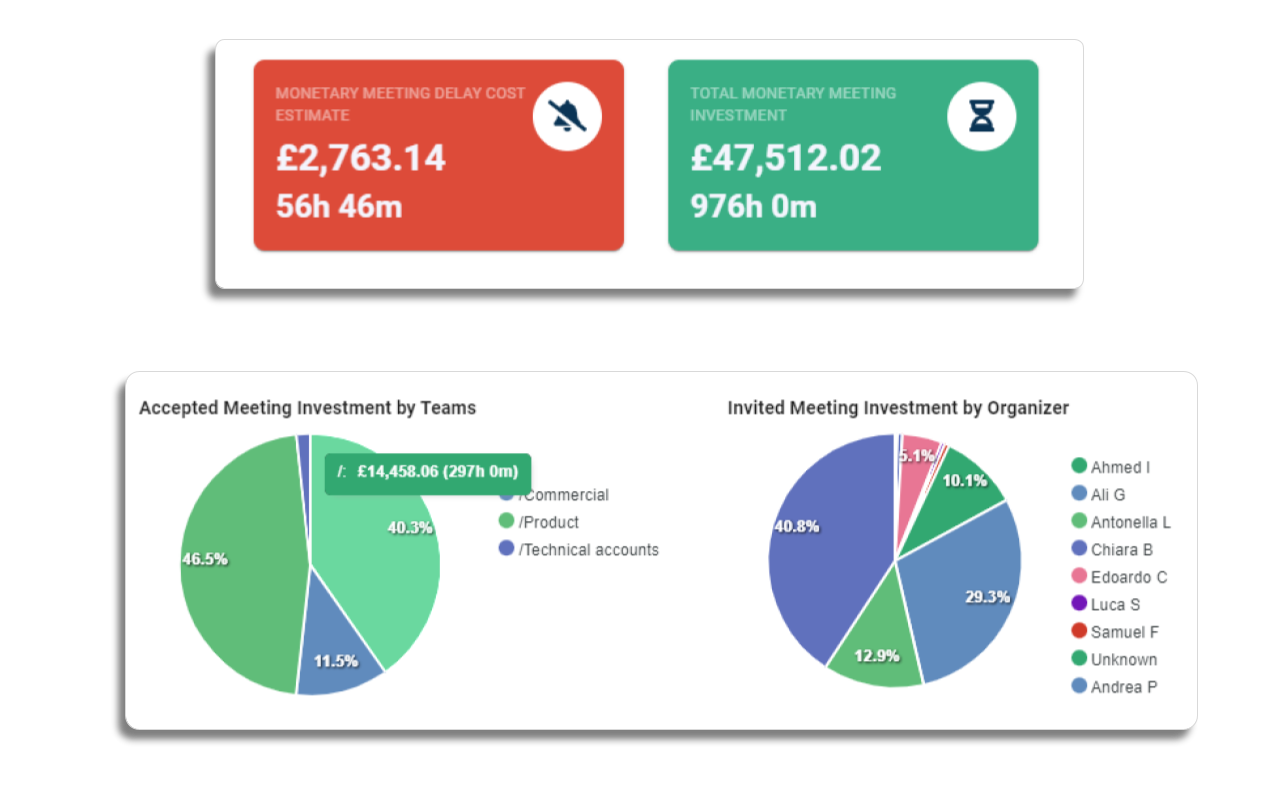
Lost Productivity: Every hour that an employee spends in a meeting is an hour not spent on other potentially revenue-generating or productive tasks. For decision-makers especially, the time they spend in one meeting could have been used to devise strategies, oversee important projects, or engage with high-value clients.
Delayed Projects: Meetings, especially unplanned ones, can lead to project delays. If a developer, for instance, has to attend a sudden two-hour meeting, that's two hours they're not coding, testing, or resolving issues.
Employee Morale: Over time, excessive meetings can lead to meeting fatigue, decreasing overall morale. This can indirectly influence employee turnover rates, leading to additional costs in recruitment and training.
Creativity Drain: Constant meetings can stifle creativity, as employees might find themselves in a loop of discussions without the necessary solitary time to think, innovate, and create.
The baffling aspect in many meeting cultures is the ease with which these costs are ignored. As mentioned earlier, in some cases, a company might readily organize a $20,000 recurring meeting (bi-weekly meeting of 10 managers for an hour for a year), without batting an eyelid but will hesitate or scrutinize a minor expense related to client entertainment or team welfare. This skewed perception can be attributed to several factors:
Visibility: The cost of a meeting is often spread out and not immediately visible, unlike direct expenses that show up clearly in financial statements.
Perceived Value: Meetings, being decision-making and collaborative arenas, are often considered inherently valuable, irrespective of their actual outcomes.
Inertia and Habit: "We’ve always done it this way" can be a powerful driver of corporate behavior. Meetings are often a deeply ingrained habit, their value and frequency rarely questioned.
Given this backdrop, how does a company keep track of these costs and ensure that every meeting is worth its weight in gold (or at least in dollars)?
This is where our recommendation of the "Meeting Cost Calculator" for Google Calendar becomes invaluable. By automatically calculating the cost of each meeting based on participant salaries and duration, this tool offers a much-needed visibility into the real price of every calendar invite being sent.
For decades, companies have been searching for ways to make meetings more effective, and while there are countless strategies and methodologies available, few address the crux of the issue: the underlying costs. Enter the "Meeting Cost Calculator", a revolutionary tool designed to change the way we approach meetings by providing tangible insights into their true cost.
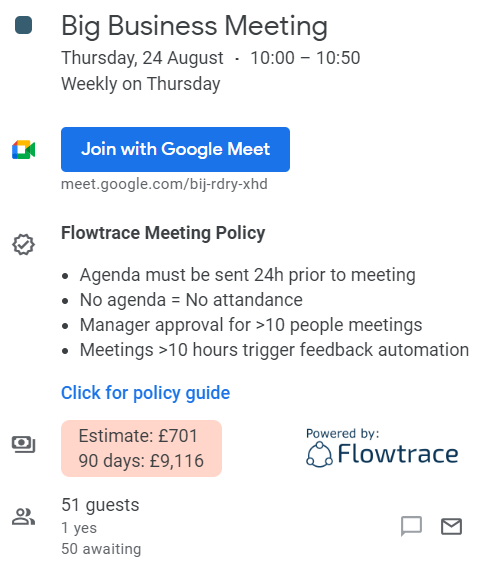
Integration with Google Calendar: One of the strengths of the "Meeting Cost Calculator" is its seamless integration with Google Calendar. It operates in the background, meaning there's no disruptive change to the way employees set up or attend meetings.
Auto-Calculation Feature: By inputting basic data such as employee salaries or hourly rates, the calculator automatically computes the cost of a meeting based on its duration and the number of attendees. This real-time feedback can be a wake-up call for many meeting organizers.
Meeting Policy Reminder: You can choose to include a brief reminder about your company's meeting policy to every meeting being organized. This reminder is sure way to get team be aware of the cost of the meetings.
Promotes Efficiency: When organizers and participants are aware of the financial implications of a meeting, there's a natural inclination to keep things efficient and on-topic.
Rationalizing Meeting Necessity: By visualizing the cost, teams might reconsider the need for certain meetings, leading to fewer, more focused discussions.
Budget Allocation: Having a clear idea of how much is spent on meetings can help finance and managerial teams allocate budgets more effectively, potentially reallocating funds to more productive avenues.
Comparative Analysis: Over a quarter or year, leaders can pull data on meeting costs to understand trends, identify departments or teams that might be over-relying on meetings, and strategize on how to make meetings more value-driven.
Training and Workshops: HR and training departments can use the data as part of larger workshops on time management and productivity, providing employees with a tangible metric to understand the implications of their scheduling habits.
Prioritizing Value over Duration: Instead of meetings that drag on without clear outcomes, there's a shift towards valuing meetings by their results, not by their length.
Encouraging Accountability: With a clear cost attached, there's greater responsibility for every participant to contribute meaningfully.
Creating a More Mindful Workspace: The transparency offered by the calculator can be the foundation for a corporate culture that values mindfulness in scheduling, respecting both the company's financial resources and individual time.
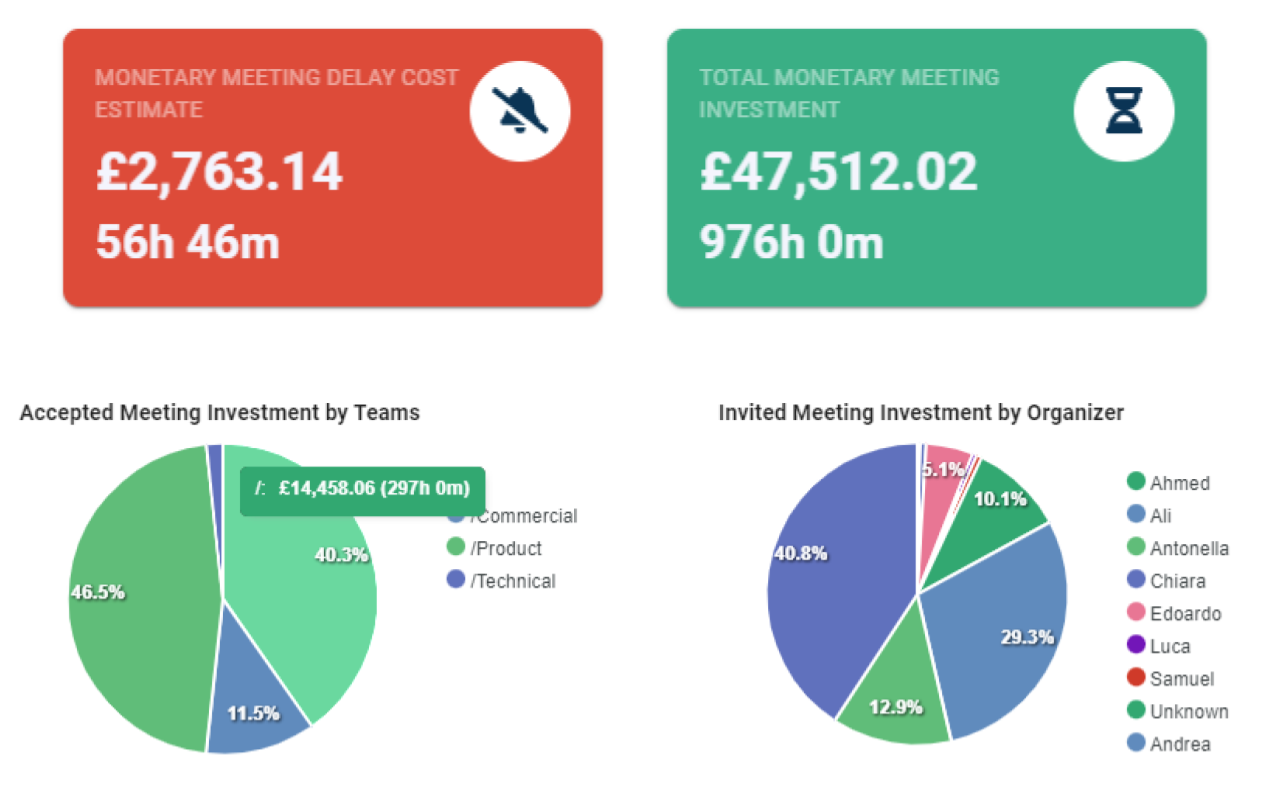
The "Meeting Cost Calculator" is not just a tool—it's a potential catalyst for change in the corporate world. While its primary function is to compute costs, its real value lies in the awareness it brings and the behavioral shifts it can inspire. You can combine this transformation with our full suite of Meeting Analytics to observe and measure the trends of your meetings.
The potential of the "Meeting Cost Calculator" is vast. However, its efficacy relies not just on its integration, but how it's woven into the fabric of a company's ethos and daily operations. This chapter dives deep into the practical steps and considerations for companies to make the most out of this transformative tool.
Notification: Before fully integrating the tool, introduce the concept and its benefits to the team. Offer support channel to make the process smooth.
Customization: Ensure that the calculator is set up to consider your company's specific pay structures, bonuses, and other factors that might affect the true cost of a meeting.
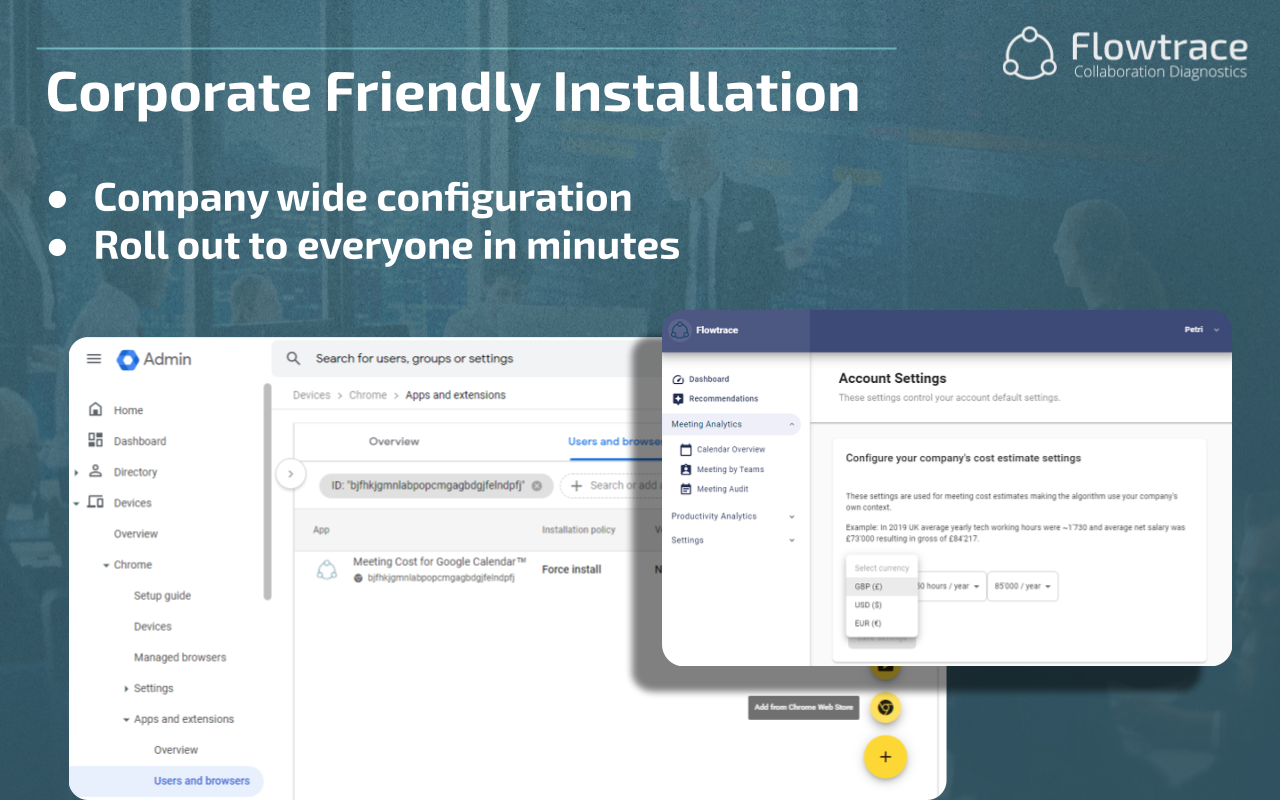
Management Support: Having the backing of higher-ups is crucial. When leadership recognizes the value and actively promotes the tool, it trickles down through the company hierarchy.
Report progress: Share instances where the tool has led to increased efficiency or a significant reduction in unnecessary meeting costs. Celebrate teams that are utilizing it effectively. Have a month worth of data in hand from Flowtrace and report the data a month after the tool has been deployed. We are certain your meeting waste drops significantly "over night".
Rewards and Recognition: Introduce a reward system for departments or teams that effectively utilize the calculator to reduce superfluous meeting costs and increase productivity.
Open Dialogue: Encourage open conversations around the tool. Create platforms where employees can share their experiences, tips, and strategies for maximizing the calculator's benefits.
Be prepared for a big change, but with a word of caution: while the "Meeting Cost Calculator" presents a compelling solution to an age-old corporate dilemma, its true value is unlocked when companies actively embed it within their operational and cultural framework. Through conscious effort, regular engagement, and a willingness to adapt, companies can transition from seeing meetings as mere costs, to viewing them as carefully considered investments in their future.
With the "Meeting Cost Calculator" firmly in place, it's essential to periodically measure and evaluate its impact on the organization. But how do you go about gauging its true value? This chapter dives into metrics, indicators, and anecdotal evidence that companies can look out for.
Meeting Hours Saved: Track the reduction in unnecessary meeting hours since the integration of the calculator.
Monetary Savings: Translate the hours saved into the monetary value using the calculator's metrics to derive tangible savings figures.
Increased Productivity: Monitor any upticks in productivity or project delivery speeds post-calculator adoption.
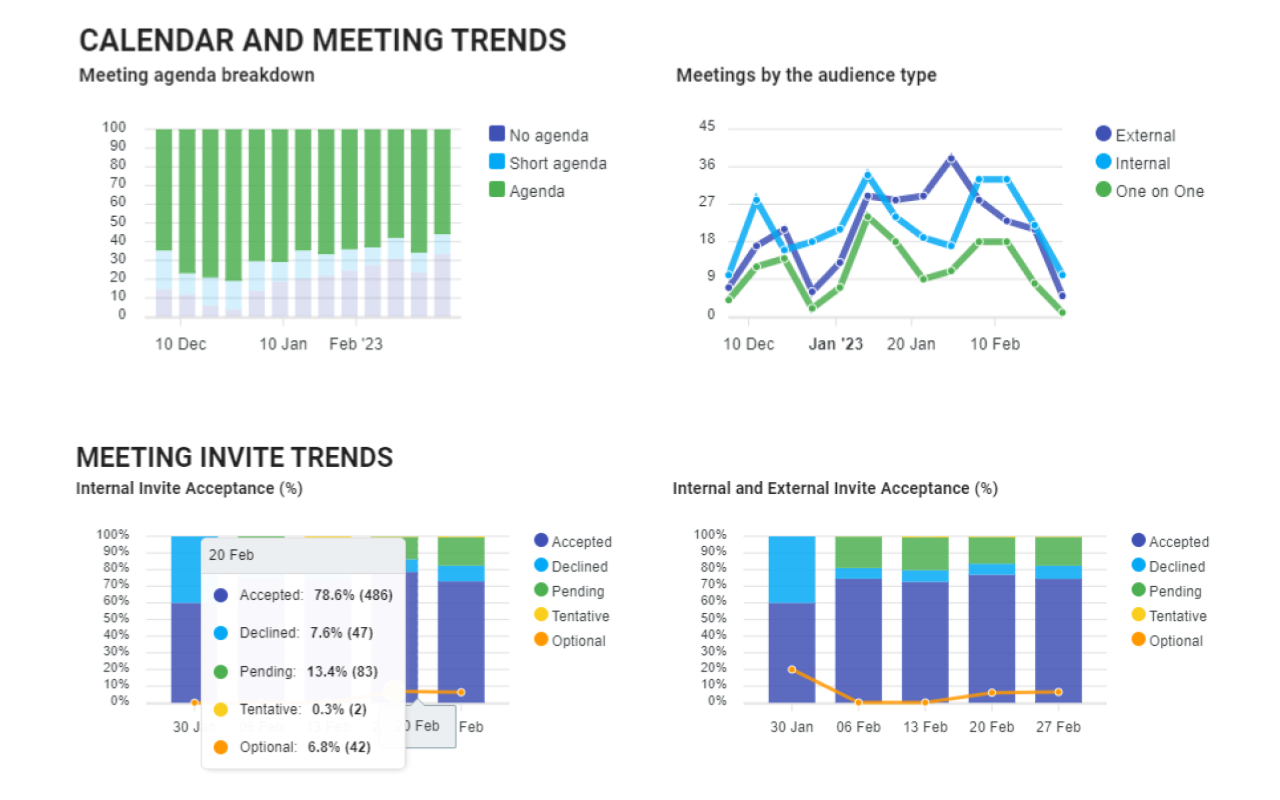
Btw. you can measure all above with Flowtrace.
Employee Satisfaction: Solicit feedback on how the awareness of meeting costs has affected employee morale, stress levels, and overall job satisfaction.
Quality of Meetings: Instead of just the number, focus on the qualitative improvement in the meetings. Are they more structured? Is there improved participation?
Over-correction: It's possible that some teams might reduce meetings to an extent that it hampers communication. Be wary of this.
Feedback Loop: Establish channels for teams to communicate challenges or unintended consequences of using the calculator.
Client Relations: Has the tool impacted client interactions in any way? Has it led to more streamlined client meetings or reduced overheads which can be passed on as savings?
Brand Image: Being conscious of time and cost can also play well externally. Monitor if and how this calculator and the resulting efficiencies affect the company's image in the industry.
As we navigate the intricate tapestry of corporate culture, meetings are undeniably one of its most quintessential threads. However, with time and evolving business landscapes, the need to reassess and reevaluate the structure, intent, and cost of these meetings has never been more paramount. Our journey through the importance of recognizing the true costs of meetings, the innovative solutions available, and their broader implications provides several key takeaways.
Raising Awareness: Awareness is the first step towards change. Recognizing that a typical meeting isn't just an hour out of a day, but involves costs, preparation, and often aftermath discussions, reshapes our approach to scheduling them.
The Power of Technology: The "Meeting Cost Calculator" isn't just a tool—it's a reflection of how technology can drive transformative change in the business realm. By making abstract costs tangible, it empowers organizations to make informed decisions and prioritizes efficiency.
Dynamic Adaptation: As the corporate world changes, so must our tools and approaches. The continuous iteration and adaptability of resources like the meeting calculator exemplify the need for businesses to be agile and receptive to change.
A Cultural Shift: The adoption of tools like the "Meeting Cost Calculator" isn't just about saving money—it's indicative of a larger cultural shift. Businesses are moving towards a more intentional, data-driven, and employee-friendly modus operandi. Prioritizing employee time, reducing burnout, and fostering an environment where meetings have clear intent and value are hallmarks of this shift.
The Journey Ahead: While the calculator provides a robust solution for today's challenges, the future of corporate meetings is a vast expanse waiting to be explored. With evolving work models, technological advancements, and global trends, there will always be new challenges and opportunities on the horizon.
In essence, our perspective on meetings needs a paradigm shift. It's not just about bringing people together but ensuring that every meeting holds value, is respectful of participants' time, and contributes positively to the broader organizational goals. As we move forward, tools like the "Meeting Cost Calculator" serve as guiding lights, reminding us of the delicate balance between collaboration and efficiency. The onus is on us—the corporate community—to wield these tools wisely, always striving for a more productive, cost-effective, and mindful future.
The cost of late meetings can be devastating to a company with lost time and money. Most businesses aren't even aware of how much late meetings cost...
Learn how Flowtrace's 'Meeting Costs for Google Calendar' extension tackles meeting overload by quantifying costs, improving efficiency, and...
Integrate Google Calendar and Flowtrace to unveil the real costs of meetings: With our analytics you can fosters better meeting culture and save...